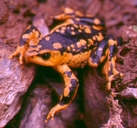|
Atelopus patazensis Venegas, Catenazzi, Siu-Ting & Carrillo, 2008
Harlequin Frog | family: Bufonidae genus: Atelopus |
| Species Description: Venegas PJ, Catenazzi A, Siu-Ting K, Carrillo J. 2008. Two new harlequin frogs (Anura: Atelopus) from the Andes of northern Peru. Salamandra 44(3): 163-176. | |
 © 2008 Alessandro Catenazzi (1 of 3) |
|
|
|
Description Description: Atelopus patazensis has a robust body. The SVL of males is 37.8-39.8 mm and of females is 42.7-48.8 mm. The head length is about equal to the head width. A. patazensis has neither tympanic membrane nor tympanic annulus. The snout is truncated when viewed from the dorsal side and extends past the lower jaw. The forearms are short. The fingers have rounded pads and lack a circum-marginal groove. Relative length of fingers in increasing order are as follows: I,II,IV,III. The front foot is not webbed but the hind foot is webbed. The body’s dorsal surface on both males and females has warts. Females have pointed projections in the skin present in the postorbital area, dorsolaterally, and on the sides. Males have a row of large warts dorsolaterally and spiculae posteriorly on the throat and under the jaw (Venegas et al. 2008). Coloration: Colors vary dorsally from almost entirely black with orange patterning to almost entirely orange with black patterning. The pupil is black and fully encircled by a ring of dark gold. Preserved specimens lose their orange color and appear yellow. Colors vary dorsally from almost entirely black with orange patterning to almost entirely orange with black patterning (Venegas et al. 2008). Tadpole Morphology: A. patazensis belongs to the family Bufonidae, all of which have type IV tadpole morphology (Venegas et al. 2008). Distribution and Habitat Country distribution from AmphibiaWeb's database: Peru
Life History, Abundance, Activity, and Special Behaviors Trends and Threats Relation to Humans Possible reasons for amphibian decline Urbanization Comments Etymology: The word “patazensis” comes from Pataz, the location in Peru where A. patazensis was found (Venegas et al. 2008). Synonymy/Taxonomy: A. patazensis was originally identified as A. pachydermis by Rodriguez in 1993 (Venegas et al. 2008).
References
Catenazzi, A., Lehr, E., Rodriguez, L., and Vredenberg, V. (2011). ''Batrachochytrium dendrobatidis and the collapse of anuran species richness and abundance in the Upper Manu National Park, southeastern Peru.'' Conservation Biology, 5, 382-391. Venegas, P., Catenazzi, A., Siu-Tang, K., and Carillo, J. (2008). ''Two new harlequin frogs (Anura: Atelopus) from the Andes of northern Peru.'' Salamandra, 44, 163-176. Originally submitted by: Jillian Howard, Thi Ngo, and Galena Robertson (first posted 2011-04-20) Edited by: Kandys Kim (2012-03-05) Species Account Citation: AmphibiaWeb 2012 Atelopus patazensis: Harlequin Frog <https://amphibiaweb.org/species/7185> University of California, Berkeley, CA, USA. Accessed Jun 2, 2025.
Feedback or comments about this page.
Citation: AmphibiaWeb. 2025. <https://amphibiaweb.org> University of California, Berkeley, CA, USA. Accessed 2 Jun 2025. AmphibiaWeb's policy on data use. |



 Map of Life
Map of Life